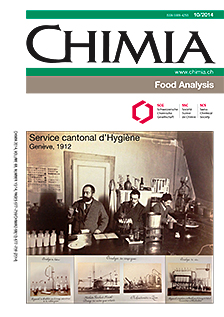Prenyl Ethers: Novel Fungal Volatiles Formed by Penicillium digitatum
DOI:
https://doi.org/10.2533/chimia.2014.692Keywords:
Citrus, Hazelnut, Prenyl ethyl ether, Prenyl isopropyl ether, Prenyl methyl ether, Volatile microbial metabolitesAbstract
Prenyl ethyl ether (PEE) was previously described as the cause for a solvent-like off-note in ground hazelnuts, but its origin remained unclear. Investigations were carried out by analytical groups of Coop and Givaudan over four years to elucidate this phenomenon. From mouldy citrus fruits a strain of Penicillium digitatum was isolated and found to form PEE. Formation on citrus and other fruits was prominent and contributed to the particular smell of decayed fruits. Several strains of P. digitatum formed PEE, while other fungal species did not. In contrast to citrus fruit, prenyl methyl ether (PME) was formed as dominant prenyl ether on hazelnuts while only small amounts of PEE were found. PME has not been previously described as volatile metabolite of fungi or as a food-taint. Spiking experiments with deuterated ethanol showed that the ethyl group is likely incorporated into PEE via the aldehyde form. On hazelnuts strongly decayed by P. digitatum yet another prenyl ether was tentatively identified: Prenyl isopropyl ether. Prenyl ethers present a novel group of volatile metabolites of P. digitatum. They are likely typical for this species and have not been described before. Prenyl ethers seem to play a significant role in the smell of food decayed by P. digitatum and should be considered in cases of off-notes and taints.Downloads
Published
2014-10-29
Issue
Section
Scientific Articles
License
Copyright (c) 2014 Swiss Chemical Society

This work is licensed under a Creative Commons Attribution-NonCommercial 4.0 International License.
How to Cite
[1]
Chimia 2014, 68, 692, DOI: 10.2533/chimia.2014.692.







